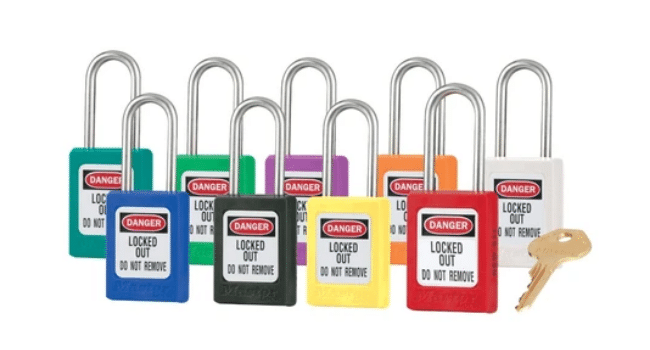Table of Contents
Lockout tagout equipment is an essential tool in ensuring that electrical machinery cannot be turned on accidentally (or maliciously) during repair or routine maintenance.
If you’re looking to purchase lockout tagout equipment or want to know more about the tools, keep reading this guide to find out.
What is lockout tagout equipment?
The term “lockout tagout” refers specifically to procedures used to ensure that equipment is shut down and inoperable until work is completed.
How does lockout tagout work?
The lockout tagout procedure happens in steps:
- Firstly, workers are made aware that a lockout procedure is about to take place.
- Next, the machine or equipment is shut down correctly according to the manufacturer’s instructions.
- After shutting down has occurred all the energy sources should now be isolated.
- Lockout devices can then be applied, and the machine should be inspected for any remaining movement.
- Now comes the try-out phase, where the restart of a machine is safely attempted. If the procedure has been implemented correctly the restart should fail.
- Any work or maintenance on the machine or device can now be safely carried out.
- Once the work is complete the lockout devices can be removed and the equipment can be safely restarted.
Why is lockout tagout equipment useful?
Lockout tagout kits ensure the safety of employees by preventing a variety of dangerous incidents from occurring. Bear in mind that industrial equipment has several potentially hazardous energy sources beyond the obvious electrical ones. These can include:
- Mechanical energy: from moving parts that rotate, cut or crush.
- Chemical energy: from chemical reactions.
- Thermal energy: from a heat source such as a boilers or furnace.
- Stored energy: from batteries.
Accidental exposure to any one of the types of hazardous energy can cause serious bodily harm, or even lead to death. That’s why ensuring you have the correct safety equipment on site for your machinery is so important.
What are the different parts of lockout tagout equipment?
Lockout kits include equipment to meet a number of different lockout requirements and are supplied in a tough case for easy storage, organization and portability. There are a few essentials for every lockout kit including:
- Safety padlock: the correct safety padlock, specifically designed for your chosen lockout tagout purpose, will help to ensure a safe system of work.
- Identifier tag: this provides a visual method of identifying who applied the lock, as the only person who is permitted to remove a lockout procedure is the same person who applied it. Tags include important information including name, type of isolation and the date of the lockout, and sometimes even a photograph.
- Lockout hasp: during a multi-person lockout procedure, a lockout hasp allows energy sources to be isolated by more than one worker. This means that the device or machine cannot be restarted until all workers have removed their lock from the hasp.
- Additional parts: there are some extra parts that can be purchased to add to your safety kit. This includes a key cabinet in which you can store individual keys, ensuring only authorized personnel are able to access them. Lockout stations may also come in handy as they provide you with a safe space to store all your lockout tagout equipment together. This ensures that all the sensitive equipment doesn’t fall into the wrong hands and is not misused or misplaced.
Is lockout tagout equipment right for my workplace?
If your workplace handles dangerous machines or any device that could potentially emit hazardous energy, it’s probably a good idea to invest in the correct lockout tagout equipment.
This not only helps to make your workplace a much safer environment for your staff to work in but also avoids your business landing any hefty fines from the Health and Safety Executive (HSE).
Read more on KulFiy
